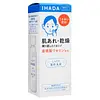What's inside
What's inside
 Key Ingredients
Key Ingredients

 Benefits
Benefits

 Concerns
Concerns

No concerns
 Ingredients Side-by-side
Ingredients Side-by-side

Water
Skin ConditioningHydrogenated Polydecene
EmollientGlycerin
HumectantEthylhexyl Stearate
EmollientCetearyl Alcohol
EmollientDimethicone
EmollientCrambe Abyssinica Seed Oil
Skin ConditioningPolyester-7
Skin ConditioningGlyceryl Stearate
EmollientXylitylglucoside
HumectantNeopentyl Glycol Diheptanoate
Emollient1,2-Hexanediol
Skin ConditioningBehenyl Alcohol
EmollientC10-18 Triglycerides
EmollientAminopropanediol
BufferingCeteareth-33
CleansingDipotassium Glycyrrhizate
HumectantElaeis Guineensis Oil
EmollientOleyl Alcohol
EmollientPhytosterols
Skin ConditioningAnhydroxylitol
HumectantCamelina Sativa Seed Oil
Skin ConditioningHydrolyzed Rice Protein
Skin ConditioningSodium Hyaluronate
HumectantTocopheryl Acetate
AntioxidantXylitol
HumectantTriethanolamine
BufferingAmmonium Acryloyldimethyltaurate/Vp Copolymer
Ceteth-20
CleansingCetyl Alcohol
EmollientDisodium EDTA
PEG-75 Stearate
Steareth-20
CleansingChlorphenesin
AntimicrobialPhenoxyethanol
PreservativeWater, Hydrogenated Polydecene, Glycerin, Ethylhexyl Stearate, Cetearyl Alcohol, Dimethicone, Crambe Abyssinica Seed Oil, Polyester-7, Glyceryl Stearate, Xylitylglucoside, Neopentyl Glycol Diheptanoate, 1,2-Hexanediol, Behenyl Alcohol, C10-18 Triglycerides, Aminopropanediol, Ceteareth-33, Dipotassium Glycyrrhizate, Elaeis Guineensis Oil, Oleyl Alcohol, Phytosterols, Anhydroxylitol, Camelina Sativa Seed Oil, Hydrolyzed Rice Protein, Sodium Hyaluronate, Tocopheryl Acetate, Xylitol, Triethanolamine, Ammonium Acryloyldimethyltaurate/Vp Copolymer, Ceteth-20, Cetyl Alcohol, Disodium EDTA, PEG-75 Stearate, Steareth-20, Chlorphenesin, Phenoxyethanol
Allantoin
Skin ConditioningDipotassium Glycyrrhizate
HumectantWater
Skin ConditioningGlycerin
HumectantC20 Olefin
Dipropylene Glycol
HumectantButylene Glycol
HumectantPentaerythrityl Tetraethylhexanoate
EmollientGlyceryl Isostearate
EmollientPetrolatum
EmollientIsopropyl-Tetramethyl-Dioxane
PerfumingGlycol Stearate
EmollientBehenyl Alcohol
EmollientBatyl Alcohol
EmollientPolyvinylalcohol Crosspolymer
PEG/PPG-17/4 Dimethyl Ether
Skin ConditioningPotassium Hydroxide
BufferingXanthan Gum
EmulsifyingPhytosteryl/Octyldodecyl Lauroyl Glutamate
Skin ConditioningSodium Metaphosphate
BufferingSodium Metabisulfite
AntioxidantCalcium Chloride
AstringentMagnesium Chloride
Sodium Glutamate
MaskingSodium PCA
HumectantPhenoxyethanol
PreservativeAllantoin, Dipotassium Glycyrrhizate, Water, Glycerin, C20 Olefin, Dipropylene Glycol, Butylene Glycol, Pentaerythrityl Tetraethylhexanoate, Glyceryl Isostearate, Petrolatum, Isopropyl-Tetramethyl-Dioxane, Glycol Stearate, Behenyl Alcohol, Batyl Alcohol, Polyvinylalcohol Crosspolymer, PEG/PPG-17/4 Dimethyl Ether, Potassium Hydroxide, Xanthan Gum, Phytosteryl/Octyldodecyl Lauroyl Glutamate, Sodium Metaphosphate, Sodium Metabisulfite, Calcium Chloride, Magnesium Chloride, Sodium Glutamate, Sodium PCA, Phenoxyethanol
Ingredients Explained
These ingredients are found in both products.
Ingredients higher up in an ingredient list are typically present in a larger amount.
Behenyl Alcohol is a type of fatty alcohol (these are different from the drying, solvent alcohols).
Fatty Alcohols have hydrating properties and are most often used as an emollient or to thicken a product. They are usually derived from natural fats and oils; behenyl alcohol is derived from the fats of vegetable oils.
Emollients help keep your skin soft and hydrated by creating a film that traps moisture in.
In 2000, Behenyl Alcohol was approved by the US as medicine to reduce the duration of cold sores.
Learn more about Behenyl AlcoholDipotassium Glycyrrhizate comes from licorice root.
Extracts of licorice have demonstrated to have antibacterial, anti‐inflammatory, antiviral, antioxidant properties.
One component, glabridin, has extra potent antioxidant and soothing properties. It has also been found to block pigmentation from UVB rays in guinea pigs.
Licorice Root also contains a flavonoid. Flavonoids are a natural substance from in plants. Flavonoids also have antioxidant properties.
Another component, glycyrrhizin, has been found to have anti-inflammatory and antimicrobial benefits. This may make licorice root extract effective at treating acne. However, more research is needed to support this.
Liquiritin is one of the flavone compounds found in licorice. It has been found to help lighten skin by preventing tyrosinase from reacting with tyrosine. When the two react, protein is converted to melanin. Melanin is the substance in your body that gives your features pigmentation.
Licorice root is native to Southern Europe and Asia. It has been used in traditional Chinese medicine to help with respiratory issues.
Learn more about Dipotassium GlycyrrhizateGlycerin is already naturally found in your skin. It helps moisturize and protect your skin.
A study from 2016 found glycerin to be more effective as a humectant than AHAs and hyaluronic acid.
As a humectant, it helps the skin stay hydrated by pulling moisture to your skin. The low molecular weight of glycerin allows it to pull moisture into the deeper layers of your skin.
Hydrated skin improves your skin barrier; Your skin barrier helps protect against irritants and bacteria.
Glycerin has also been found to have antimicrobial and antiviral properties. Due to these properties, glycerin is often used in wound and burn treatments.
In cosmetics, glycerin is usually derived from plants such as soybean or palm. However, it can also be sourced from animals, such as tallow or animal fat.
This ingredient is organic, colorless, odorless, and non-toxic.
Glycerin is the name for this ingredient in American English. British English uses Glycerol/Glycerine.
Learn more about GlycerinPhenoxyethanol is a preservative that has germicide, antimicrobial, and aromatic properties. Studies show that phenoxyethanol can prevent microbial growth. By itself, it has a scent that is similar to that of a rose.
It's often used in formulations along with Caprylyl Glycol to preserve the shelf life of products.
Water. It's the most common cosmetic ingredient of all. You'll usually see it at the top of ingredient lists, meaning that it makes up the largest part of the product.
So why is it so popular? Water most often acts as a solvent - this means that it helps dissolve other ingredients into the formulation.
You'll also recognize water as that liquid we all need to stay alive. If you see this, drink a glass of water. Stay hydrated!
Learn more about Water